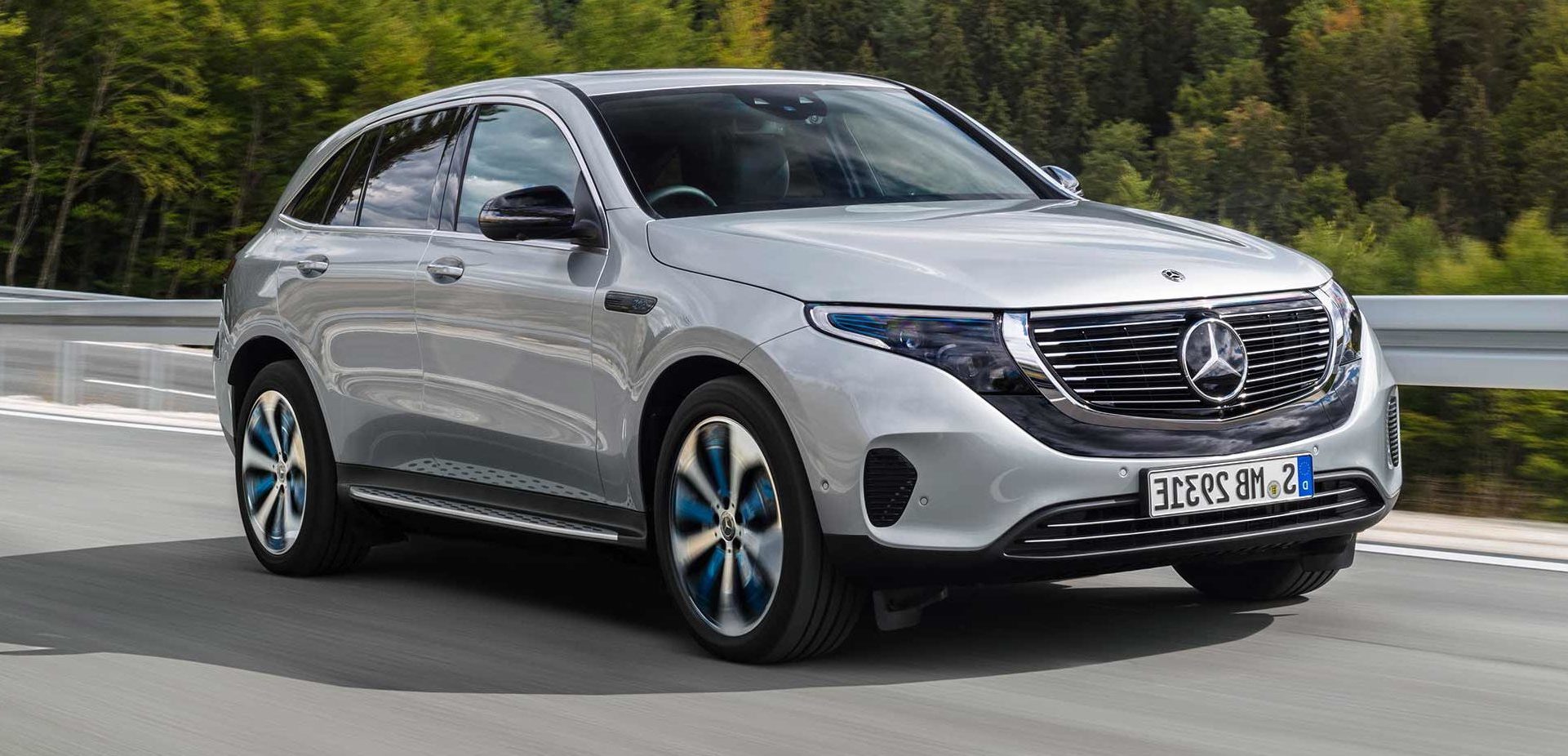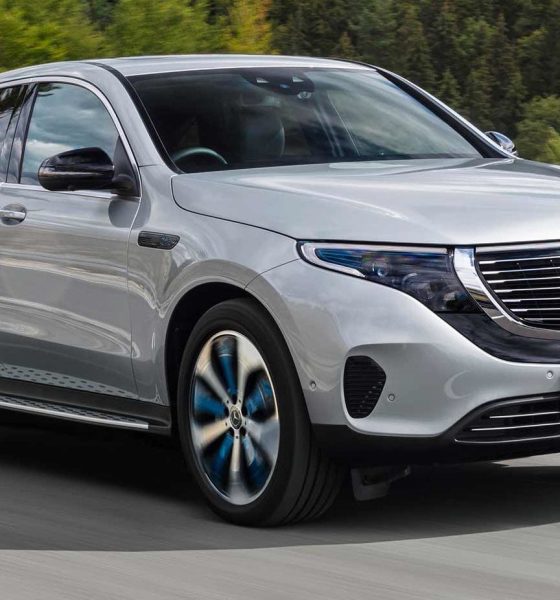

News
Once-deemed ‘Tesla killer’ Mercedes EQC flops with 55 units sold in Germany to date
Tesla appears poised to extend its reach into the heart of Das Auto, but it seems like Mercedes-Benz, a member of the old guard, may not be up to the task of meeting the young electric car maker’s challenge head-on. Daimler, for one, seems to be struggling in its home court, selling only 55 units of the its first all-electric SUV, the once-deemed “Tesla Killer” Mercedes-Benz EQC, since it was released in Germany.
German publication Welt noted that the veteran car manufacturer is hesitant to reveal information about the EQC’s sales, but data from the Federal Motor Transport Authority (KBA) revealed that there were only 19 units of the SUV that were sold in November 2019. Since the vehicle was released in the country, registrations for the vehicle have only numbered 55. It’s a painful pill to swallow, but it seems that Mercedes-Benz’s tagline for the EQC campaign, “Enjoy Electric,” is far from convincing local consumers.
Welt aptly puts it: “The car is not only widely advertised, but has also been delivered for a few months. And at the last major e-car premiere that Germany experienced this year, numerous Tesla Model 3s drove through the area after just a few weeks. So where are the electric models from Stuttgart?”
According to the same report, there are clear indications that Daimler spent a lot to ensure its market feels the presence of the Mercedes EQC. The electric SUV appears on TV spots, movie screens, and billboards. It seems like the only place where the electric Mercedes-Benz is nowhere to be found is on the country’s roads, or people’s garages.
What’s happening to Daimler is only part of the bigger picture of what’s happening in the German automotive industry. As Tesla makes the most out of its momentum hoping to hurdle the last steps to finally begin construction of the Gigafactory 4 in Germany, local manufacturers seem to slide and struggle.
Gigafactory 4 will open opportunities for Tesla in Germany by first producing the Model Y crossover, which happens to be a cheaper alternative to the Mercedes-Benz EQC. Meanwhile, Daimler announced back in November that it will reduce its workforce and cut around 9,500 jobs across the globe as it switches its focus on electric cars.
The low sales number of the EQC might only be the tip of the iceberg. While Tesla has been setting trends and transforming the auto industry, Germany’s giants might have been caught resting on their laurels and were caught by surprise how a young company from California can slay them in the electric vehicle race.
Cars and Germany cannot be separated as more than 800,000 people depend on the industry to put food on their tables. It’s a complicated story why automotive giants such as Daimler cannot keep up with the future and just see Tesla cruise pass them.
One might just wonder if Mercedes cannot sell its electric SUV in its own backyard, how will its electric vehicles do in other markets that it depends on for revenue, such as China and the United States? The company has announced that it is delaying the release of the EQC in the US for another year, which does not bode well for the vehicle. As for Tesla, the game to conquer Europe begins soon with Tesla Gigafactory 4, and it has already opened the floodgates in China with the first deliveries of its mass-produced Model 3 electric sedans.
H/T to @Alex_avoigt

News
Nvidia CEO Jensen Huang explains difference between Tesla FSD and Alpamayo
“Tesla’s FSD stack is completely world-class,” the Nvidia CEO said.

NVIDIA CEO Jensen Huang has offered high praise for Tesla’s Full Self-Driving (FSD) system during a Q&A at CES 2026, calling it “world-class” and “state-of-the-art” in design, training, and performance.
More importantly, he also shared some insights about the key differences between FSD and Nvidia’s recently announced Alpamayo system.
Jensen Huang’s praise for Tesla FSD
Nvidia made headlines at CES following its announcement of Alpamayo, which uses artificial intelligence to accelerate the development of autonomous driving solutions. Due to its focus on AI, many started speculating that Alpamayo would be a direct rival to FSD. This was somewhat addressed by Elon Musk, who predicted that “they will find that it’s easy to get to 99% and then super hard to solve the long tail of the distribution.”
During his Q&A, Nvidia CEO Jensen Huang was asked about the difference between FSD and Alpamayo. His response was extensive:
“Tesla’s FSD stack is completely world-class. They’ve been working on it for quite some time. It’s world-class not only in the number of miles it’s accumulated, but in the way it’s designed, the way they do training, data collection, curation, synthetic data generation, and all of their simulation technologies.
“Of course, the latest generation is end-to-end Full Self-Driving—meaning it’s one large model trained end to end. And so… Elon’s AD system is, in every way, 100% state-of-the-art. I’m really quite impressed by the technology. I have it, and I drive it in our house, and it works incredibly well,” the Nvidia CEO said.
Nvidia’s platform approach vs Tesla’s integration
Huang also stated that Nvidia’s Alpamayo system was built around a fundamentally different philosophy from Tesla’s. Rather than developing self-driving cars itself, Nvidia supplies the full autonomous technology stack for other companies to use.
“Nvidia doesn’t build self-driving cars. We build the full stack so others can,” Huang said, explaining that Nvidia provides separate systems for training, simulation, and in-vehicle computing, all supported by shared software.
He added that customers can adopt as much or as little of the platform as they need, noting that Nvidia works across the industry, including with Tesla on training systems and companies like Waymo, XPeng, and Nuro on vehicle computing.
“So our system is really quite pervasive because we’re a technology platform provider. That’s the primary difference. There’s no question in our mind that, of the billion cars on the road today, in another 10 years’ time, hundreds of millions of them will have great autonomous capability. This is likely one of the largest, fastest-growing technology industries over the next decade.”
He also emphasized Nvidia’s open approach, saying the company open-sources its models and helps partners train their own systems. “We’re not a self-driving car company. We’re enabling the autonomous industry,” Huang said.
Elon Musk
Elon Musk confirms xAI’s purchase of five 380 MW natural gas turbines
The deal, which was confirmed by Musk on X, highlights xAI’s effort to aggressively scale its operations.

xAI, Elon Musk’s artificial intelligence startup, has purchased five additional 380 MW natural gas turbines from South Korea’s Doosan Enerbility to power its growing supercomputer clusters.
The deal, which was confirmed by Musk on X, highlights xAI’s effort to aggressively scale its operations.
xAI’s turbine deal details
News of xAI’s new turbines was shared on social media platform X, with user @SemiAnalysis_ stating that the turbines were produced by South Korea’s Doosan Enerbility. As noted in an Asian Business Daily report, Doosan Enerbility announced last October that it signed a contract to supply two 380 MW gas turbines for a major U.S. tech company. Doosan later noted in December that it secured an order for three more 380 MW gas turbines.
As per the X user, the gas turbines would power an additional 600,000+ GB200 NVL72 equivalent size cluster. This should make xAI’s facilities among the largest in the world. In a reply, Elon Musk confirmed that xAI did purchase the turbines. “True,” Musk wrote in a post on X.
xAI’s ambitions
Recent reports have indicated that xAI closed an upsized $20 billion Series E funding round, exceeding the initial $15 billion target to fuel rapid infrastructure scaling and AI product development. The funding, as per the AI startup, “will accelerate our world-leading infrastructure buildout, enable the rapid development and deployment of transformative AI products.”
The company also teased the rollout of its upcoming frontier AI model. “Looking ahead, Grok 5 is currently in training, and we are focused on launching innovative new consumer and enterprise products that harness the power of Grok, Colossus, and 𝕏 to transform how we live, work, and play,” xAI wrote in a post on its website.
Elon Musk
Elon Musk’s xAI closes upsized $20B Series E funding round
xAI announced the investment round in a post on its official website.

xAI has closed an upsized $20 billion Series E funding round, exceeding the initial $15 billion target to fuel rapid infrastructure scaling and AI product development.
xAI announced the investment round in a post on its official website.
A $20 billion Series E round
As noted by the artificial intelligence startup in its post, the Series E funding round attracted a diverse group of investors, including Valor Equity Partners, Stepstone Group, Fidelity Management & Research Company, Qatar Investment Authority, MGX, and Baron Capital Group, among others.
Strategic partners NVIDIA and Cisco Investments also continued support for building the world’s largest GPU clusters.
As xAI stated, “This financing will accelerate our world-leading infrastructure buildout, enable the rapid development and deployment of transformative AI products reaching billions of users, and fuel groundbreaking research advancing xAI’s core mission: Understanding the Universe.”
xAI’s core mission
Th Series E funding builds on xAI’s previous rounds, powering Grok advancements and massive compute expansions like the Memphis supercluster. The upsized demand reflects growing recognition of xAI’s potential in frontier AI.
xAI also highlighted several of its breakthroughs in 2025, from the buildout of Colossus I and II, which ended with over 1 million H100 GPU equivalents, and the rollout of the Grok 4 Series, Grok Voice, and Grok Imagine, among others. The company also confirmed that work is already underway to train the flagship large language model’s next iteration, Grok 5.
“Looking ahead, Grok 5 is currently in training, and we are focused on launching innovative new consumer and enterprise products that harness the power of Grok, Colossus, and 𝕏 to transform how we live, work, and play,” xAI wrote.








